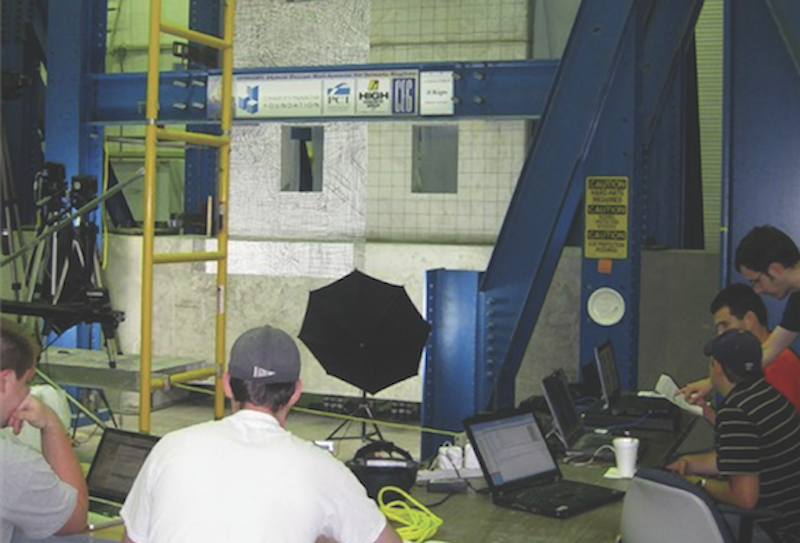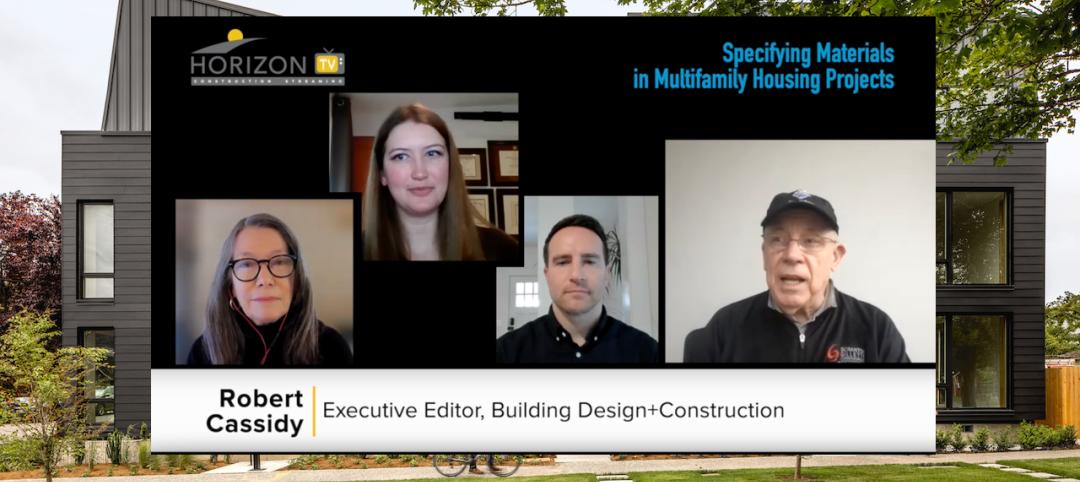In 2002, a couple of years before he died, Charles J. Pankow, Founder and Chairman of design-build firm Charles Pankow Builders, established a research foundation in his name. A pioneer in concrete-forming and moment-framing technology, Pankow was frustrated with the U.S. construction industry’s paltry support of research—a tiny fraction of 1% of revenues, compared to 11.1% of revenue for R&D in the health sector and 4.0% in the automotive, according to PwC’s 2015 Global Innovation 1000 report.
The biggest stumbling block to innovation in construction was (and is) lack of risk capital, due to sub-2% profit margins, says Richard “Rik” Kunnath, PE, Board President of the Charles Pankow Foundation (CPF). Add widespread reluctance among contractors to try anything new, coupled with the fragmentation of the AEC industry, and investing in R&D historically got short shrift.
The CPF wasn’t fettered by those restrictions. “As a nonprofit foundation, we could take risks that others could not,” says Kunnath. In 2006, the foundation started issuing grants, mostly to civil engineering profs at U.S. universities.
Results were mixed. Some of the research did lead to a few code tweaks and design improvements, but there were no breakthroughs. “We were washing the cleanest shirt in the laundry,” Kunnath admits. The foundation needed to concentrate its scarce resources where it could have the greatest impact.
Four years ago, Kunnath and Executive Director Mark J. Perniconi, PE, convened an advisory panel to identify where CPF-sponsored research could have the biggest bang for the buck.
Out of this strategic review came eight R&D initiatives that CPF would focus on (see list at left). It was a rigorous agenda, one that was very much in keeping with Charlie Pankow’s original intent: to cultivate innovation in design and construction and thereby “create buildings of improved quality, efficiency, and value.”
At the same time, the CPF board realized it could not change the AEC world on its own. It needed financial support from others. In recent years, the foundation has partnered with such entities as the ACI Foundation, the American Institute of Steel Construction (AISC), the Construction Industry Institute, the American Society of Concrete Contractors, and AEC firms Clark Construction Group, Magnusson Klemencic Associates, and Skanska USA Building.
Last year, CPF teamed up with 17 co-funders, whose investments leveraged its grant-making capability by 40-50%, says Kunnath. It was CPF’s biggest year ever: more than $2 million in grants. Let’s take a look at a few such efforts.
helping to MAKe INROADS ON BIM INTEROPERABILITY
CPF’s biggest investment—about $4 million—has been in BIM interoperability. “The SEs have their BIM software, the GCs have theirs, and the programs don’t speak to each other,” says Kunnath. CPF is supporting research at Georgia Tech to develop “translator codes” that will let the various BIM programs to talk to each other.
Out of that research came CPF’s Owners’ Guide to BIM Utilization. “It gives owners a good understanding of where BIM works, when to use it, at what level of detail,” says Kunnath. The guide has been adopted by the U.S. Army Corps of Engineers and others.
CPF has also supported BIM-M, a five-year program to encourage BIM use in masonry. It started when members of the Mason Contractors Association of America said they were being asked to bid projects using BIM. “Most had no idea how to do it,” says David Biggs, PE, SE, BIM-M Program Coordinator. “The steel and concrete people were well ahead of us in BIM.”
By the time the program sunsets next year, BIM-M will have invested about $2.2 million in R&D and BIM education for masons. “We’re supporting the development of plug-ins to make existing BIM software from Tekla and other vendors more useful to mason contractors,” says Biggs.
ENABLING STEEL AND CONCRETE R&D
Aiding research to make high-strength steel rebar a reality in the U.S. has been a major initiative. “U.S. codes don’t allow steel above 60 ksi, while the rest of the world is using 100 ksi steel,” says Kunnath. The HSS steel effort will take a decade and cost $10-15 million, but “in the end, we will have moved the U.S. into the modern era to make buildings cheaper and more globally competitive.”
CPF is partnering with AISC on concrete-filled composite plate shear walls. The three-year, $600,000 project (split evenly by CPF and AISC) will generate experimental data and numerical models leading to design guidelines for CF-CPSW core walls.
The research is being headed by Amit Varma at Purdue University. If successful, it would allow such core walls to be erected four stories at a time, using anchors and studs, with no rebar. AISC Vice President Lawrence F. Knuth, PE, says FEMA is adding $150,000 to the pot to test whether CF-CPSW walls could yield an R-value of R-8 for concrete (currently, R-6).
"We needed a new strategy. we were washing the cleanest shirt in the laundry."
Rik kunnath, PE, Charles Pankow Foundation
CPF is not alone in sponsoring AEC-related research. A number of architecture giants—Gensler, Perkins+Will, Perkins Eastman, CallisonRTKL, and GBBN, among others—routinely conduct research related to their work.
The AIA’s Academy for Architecture in Health Foundation has given $200,000 toward research in the last four years, notably for designing improved patient flow in emergency departments.
But the true catalyst for change in the construction sector has been the Charles Pankow Foundation. Since 2006, it has funded more than $12 million in research. The foundation recently pulled together a panel of 10 experts to codify best practices for high-rise construction in earthquake zones.
That initiative resulted in “Guidelines for Performance-based Design of Tall Buildings,” which details a peer-reviewed, rather than prescriptive, path for building in seismic zones.
THERE’S MORE TO COME
The foundation has been partnering with the Concrete Reinforcing Steel Institute on a multi-year project to gain industry consensus on performance specifications for high-strength rebar in seismic applications—data that will be used in modifications to the 2019 version of the ACI 318 building code.
The research is being conducted at multiple universities—Kansas and UT Austin among them—with technical help and materials donations in the $2-4 million range from steel mills and fabs.
“Having the partnership is crucial to getting all this research into practice,” says David McDonald, PhD, PE, FACI, the CRSI’s CEO.
“Research into practice.” That’s what the Charles Pankow Foundation is all about.
Related Stories
Multifamily Housing | Apr 27, 2023
Watch: Specifying materials in multifamily housing projects
A trio of multifamily housing experts discusses trends in materials in their latest developments. Topics include the need to balance aesthetics and durability, the advantages of textured materials, and the benefits of biophilia.
AEC Tech Innovation | Apr 27, 2023
Does your firm use ChatGPT?
Is your firm having success utilizing ChatGPT (or other AI chat tools) on your building projects or as part of your business operations? If so, we want to hear from you.
Concrete Technology | Apr 24, 2023
A housing complex outside Paris is touted as the world’s first fully recycled concrete building
Outside Paris, Holcim, a Swiss-based provider of innovative and sustainable building solutions, and Seqens, a social housing provider in France, are partnering to build Recygénie—a 220-unit housing complex, including 70 social housing units. Holcim is calling the project the world’s first fully recycled concrete building.
Multifamily Housing | Apr 21, 2023
Arlington County, Va., eliminates single-family-only zoning
Arlington County, a Washington, D.C., community that took shape in the 1950s, when single-family homes were the rule in suburbia, recently became one of the first locations on the East Coast to eliminate single-family-only zoning.
Green | Apr 21, 2023
Top 10 green building projects for 2023
The Harvard University Science and Engineering Complex in Boston and the Westwood Hills Nature Center in St. Louis are among the AIA COTE Top Ten Awards honorees for 2023.
Multifamily Housing | Apr 19, 2023
Austin’s historic Rainey Street welcomes a new neighbor: a 48-story mixed-used residential tower
Austin’s historic Rainey Street is welcoming a new neighbor. The Paseo, a 48-story mixed-used residential tower, will bring 557 apartments and two levels of retail to the popular Austin entertainment district, known for houses that have been converted into bungalow bars and restaurants.
Design Innovation Report | Apr 19, 2023
Reinforced concrete walls and fins stiffen and shade the National Bank of Kuwait skyscraper
When the National Bank of Kuwait first conceived its new headquarters more than a decade ago, it wanted to make a statement about passive design with a soaring tower that could withstand the extreme heat of Kuwait City, the country’s desert capital.
Design Innovation Report | Apr 19, 2023
HDR uses artificial intelligence tools to help design a vital health clinic in India
Architects from HDR worked pro bono with iKure, a technology-centric healthcare provider, to build a healthcare clinic in rural India.
Design Innovation Report | Apr 19, 2023
Meet The Hithe: A demountable building for transient startups
The Hithe, near London, is designed to be demountable and reusable. The 2,153-sf building provides 12 units of business incubator workspace for startups.
Contractors | Apr 19, 2023
Rising labor, material prices cost subcontractors $97 billion in unplanned expenses
Subcontractors continue to bear the brunt of rising input costs for materials and labor, according to a survey of nearly 900 commercial construction professionals.

















